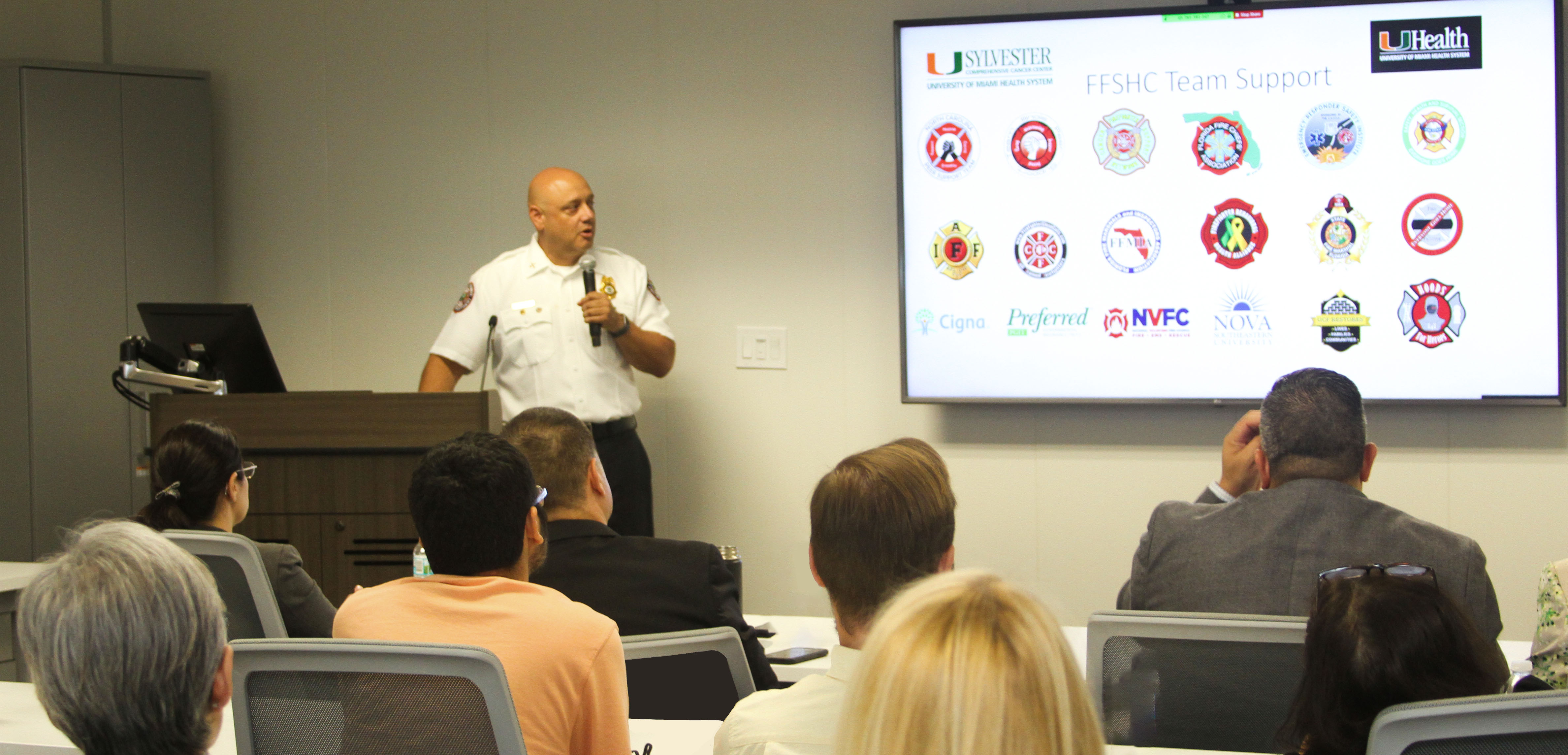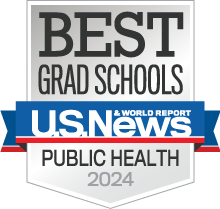Stop, Drop, and Roll: Firefighters and Scientists Team Up to Put Out Cancer Risk

The Firefighter Cancer Initiative (FCI) was launched in 2015 to better understand the burden of cancer among firefighters, which is the number one cause of line of duty death. The FCI began through a State of Florida appropriation and is currently housed in the Sylvester Comprehensive Cancer Center (SCCC), South Florida’s only National Cancer Institute-designated cancer center.
“The intent of the FCI is to understand why our first responders are at an increased risk of developing and dying of cancer. Our work has touched over 5,000 firefighters in Florida alone. This initiative is also an essential component of Sylvester's application for designation from the National Cancer Institute,” said Erin Kobetz, Ph.D., who is the director and principal investigator of the FCI, during an Interdisciplinary Research Seminar Series.
Held by the FCI, the seminar took place at the University of Miami’s Clinical and Translational Science Institute on August 28, 2019, to disseminate research and groundbreaking discoveries that are addressing this excess burden of cancer among firefighters.
Directors and investigators of the FCI, who are also faculty from the Miller School’s Department of Public Health Sciences, from the SCCC, as well as from the School of Communication, gave presentations at the seminar. They included David Lee, Ph.D., Alberto-Caban-Martinez, D.O., Ph.D., M.P.H., Sylvia Daunert, Pharm.D., M.S., Ph.D. Natasha Solle, Ph.D., RN, and Barbara Millet, Ph.D. and Chief Chris Bater from the Coral Springs Fire Department,
As the seminar began, Dr. Kobetz, gave welcoming remarks as the audience – which consisted of students, faculty, and staff – listened closely.
“Today is a really nice example of how interdisciplinary scientists and community stakeholders come together to break down silos to team science and advance meaningful progress to the impact that we hope to inspire,” Dr. Kobetz said.
Before introducing Dr. Lee, who is the senior investigator of the FCI, Dr. Kobetz also emphasized the importance of the participation of firefighters. This has made it essential for the FCI to ensure that findings are effectively translated back to the state and national fire stations, as well as to the State Fire Marshal's Office.
Dr. Lee, who is a professor of public health and director of graduate programs at the Department of Public Health Sciences, focused his presentation on giving an update on the work that he had started 15 years ago based on firefighter cancer research. His initial findings have served as the conceptual basis for the FCI for the past five years.
As a principal investigator of the Florida Cancer Data System, he created a novel registry that allows the FCI to generate population estimates of cancer risk in the fire service. It is the first of its kind and serves as a model for what other states hope to do with their registries, such as how to better understand what cancers firefighters are developing and what can be done through evidence-based practice.
“It's gratifying to be able to utilize some of our own data to compare the risk of cancer in firefighters in Florida,” Dr. Lee said. “I'm also a proud parent of a City of Miami firefighter. So, this research is personal as well.”
In an initial look at the data, Dr. Lee shared that there were increased risks of bladder, thyroid and testicular cancer in firefighters among men. He and his research team have used software to link augmented firefighter records to their cancer registry, which was efficient and a more accurate way to make probabilistic linkages.
“For a man, we're seeing about a 56 percent increase in melanoma, 36 percent for prostate, and 66 percent for testicular. And there were more than a two-fold increase in thyroid cancer in male firefighters. We also found a number of cancers that are tobacco-associated,” said Dr. Lee.
For female firefighters, they found that increased risks doubled for thyroid and brain cancer, but Dr. Lee cautioned that there were very few cases. Melanoma and rectal cancer were also elevated but were not statistically significant.
“We looked at some specific cancers for women and fortunately we're not seeing any evidence of elevations in risk for breast and cervical cancers,” he said.
Additionally, Dr. Lee added that they found increased risks for four cancers in men less than 50 years of age and for the older male firefighters, there were increased risks for melanoma, prostate, and thyroid cancer. They also looked at early versus late-stage cancers in the men, as there were not enough cases to do so in the women.
“We saw increased risks in melanoma, prostate, testicular and thyroid cancers for early-stage and then prostate, testicular and thyroid for late-stage cancers. Colon cancer was borderline significant, as was mesothelioma for late stage,” he added.
The next steps for Dr. Lee and his research team will be to look into cancer mortality, as well as examining the influence of tobacco policy in lowering the burden of tobacco-associated cancers in firefighters. They will also look into data based on volunteer firefighters, as the data that he presented were only on career firefighters.
Dr. Caban-Martinez presented after Dr. Lee, alongside Dr. Daunert, on environmental sampling. The program, a component of the FCI, gives researchers insight into the exposures that firefighters are coming across when in the field, as well as how they could potentially bring those exposures back to the fire station, their personal vehicles, and even their homes. During the seminar, he gave insight into how they think about exposure assessments in firefighter work environments.
“This is a very challenging arena, as firefighters are responding quickly and timely to a different type of fire incident response. We researchers think about how firefighters come across exposure through these different point areas. We then think about their turnout gear, how the same gear that is used to protect them might also be, in an inadvertent way, causing some of the cancer risks that we think about,” Dr. Caban-Martinez said.
They also think about the apparatus, such as the actual engine that is used to transport back and forth from incident response to the fire station as having some carcinogenic risk factors. Dr. Caban-Martinez and the team therefore sample the fire stations, as firefighters may potentially bring back exposures there, as well as into their personal vehicle and homes.
Through testing firefighter gear by using instrumentation like ionization detection, quantification of exposure and solid-state sensors, it was found that the gear continues to release gas after a fire for almost up to 24 hours.
“The proxy measure that we use for carcinogen exposure is polycyclic aromatic hydrocarbons (PAH). These are in natural products of combustion of fire and these compounds are in that plume of smoke that we see in movies that come out and our firefighters are responding to. We use those compounds to be able to get at the level of exposure,” Dr. Caban-Martinez said.
One of the technologies that he and his research team have developed is the use of silicone-based wristbands. They are developing the method and the quantification approach for how they characterize PAHs through the wristbands, which can capture the particles that they are exposed to. They can then characterize and quantify the particles.
“We also developed heat maps that allow us to characterize the type and quantity of those PAHs that they come across, characterizing them between those that have been exposed to a fire during a 24-hour shift, versus those who have not,” he said.
Dr. Caban-Martinez added that he and his research team have also been strategically placing different instrumentation to measure, for example, organic vapors that are released as part of the diesel exhaust combustion that comes out of the engine or the apparatus.
“We use an item called an SKC patch, which has specific beads that collect some of the organic compounds and are able to quantify the chemical compounds, depending on the station and depending on the interventions that are developed in them,” he added.
There is also a rover and miniaturized sensors, according to Dr. Daunert, professor of biochemistry and molecular biology at the Miller School, who shared other new technologies that have been helping in understanding and minimizing carcinogenic exposures. The rover and miniaturized sensors respond in a fast manner as PAHs are detected to determine the levels in real-time.
Dr. Millet, a research assistant professor at the School of Communication, spoke about the personal exposure reporter, a responsive web application that is used by firefighters for free. The app allows them to keep a record of their occupational exposures.
The app is set up to capture exposure data for five different types of incidents, such as fire, hazmat, and water rescue exposures. There is also a fire investigation section, as well as a section for fire training. Dr. Millet and her team provide a dashboard that presents analytics to departments, stations, and individuals.
To increase cancer prevention and education, Dr. Solle, who is a research assistant professor with the Miller School’s Department of Medicine, has been leading the efforts to increase educational implementation at the FCI.
During her presentation, she focused on the cancer prevention education curriculum. She emphasized the importance of educating firefighters based on the information that is known, as well as providing them with the tools for safety measures and hands-on training. Dr. Solle and the research team have developed educational modules, as well as videos, such as how to conduct proper decontamination processes.
Before concluding her presentation, she also mentioned the State of Science National Firefighter Cancer Symposium, an inaugural, two-day symposium that took place June of this year to develop a scientific roadmap to control and prevent cancer for the firefighters and volunteers in the U.S. Fire Service.
“We had nearly 300 firefighters and academics who came in and presented on what is the most up to date studies and research that's going on in the world of cancer and the fire service,” Dr. Solle said.
Before the seminar came to a finish, Chief Chris Bater from the Coral Springs Fire Department spoke about the endeavors of the Florida Firefighters Safety and Health Collaborative. The collaborative centers on cancer prevention, firefighter mental wellness, health, and fitness, as well as overall fire safety on scenes. He also expressed his gratitude for the FCI and SCCC.
“Much of the work the FCI and Sylvester teams have done has really impacted not only my organization but the entire Florida fire service and beyond. And as of July 1, 2019, Florida became the 47th state to provide cancer protection coverage under the law,” Chief Bater said. “And I'll tell you today that I don't believe that that would have ever happened if it wasn't for them, as well as the education and research that they provided, not only for Florida firefighters but to our legislators and our decision-makers.”
“Thank you,” he concluded. “You are truly changing lives and you're truly saving lives.”
Written by Amanda Torres
Published on September 10, 2019





